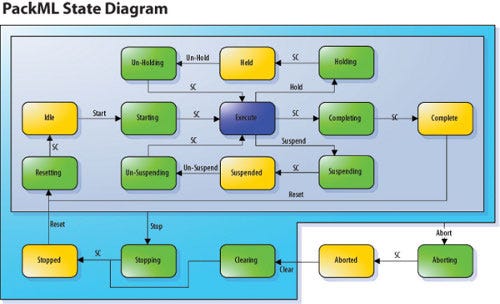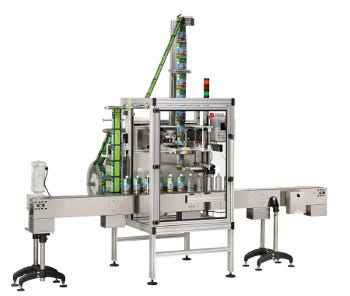March 11, 2015
PackML: At the tipping point
PackML, or Packaging Machine Language, defines a common approach for programming and machine states for automated packaging machines. The standard has been around for years but now, with the strong backing of Procter & Gamble and other large consumer packaged goods companies, a growing number of packaging machinery OEMs are making a push to support the standard.
At the heart of the initiative is the desire for a universal method of collecting production information to measure the operational effectiveness of complete packaging lines. And there are other potential benefits as well, including a common look and feel between machines and improved troubleshooting.
Strong end-user support in 2008 helped PackML gain its initial momentum. It was adopted as part of the ISA88 industry standard in August 2008 and, using the principles laid out in ISA88, the OMAC (Organization for Machine Automation and Control) group set a course based to strengthen support for the standard and endorse modular programming concepts.
Rockwell Automation also made additions to its Power Programming environment, and Version 4 now fully embraces the ISA88 modularity concepts and leverages the workings of OMAC.

PackML: At the tipping point
The OMAC PackML guidelines, which are now published in ISA-TR88.00.02, provide the broadly recognized machine state model and standardized data model (PackTags). The models provide a common set of terminologies and structures that significantly reduce the customization, time and costs associated with integration of machines with manufacturer's information systems.
In 2009, Procter & Gamble developed a PackML Implementation Guide to aid software developers in achieving a clean and efficient implementation of PackML. This guide includes software and help files for implementation on Rockwell's ControlLogix platform, and offers a simplified version of the cumbersome 125-page PackML standards document.
The OMAC Packaging Workgroup (OPW) adopted the guide and is encouraging technology providers to develop example software that follows it. A copy of the guide is available for download on the OMAC website, www.omac.org.
Preparing for the next level
Among end users, the promise of PackML is tied to the larger goal of quantifying machine effectiveness.
"My pipe dream is for PackML to do for packaging machines what USB has done for personal computers, so we can have plug-and-play packaging equipment," says Jeff Russell, TPM coach for controls and automation at Pepsi Americas Beverages Group. "If we have 10 different brands of vendors on one line, we want to be able to plug them all in through Ethernet, and the line controls integrator can already have the code prewritten when we start up the line." Russell continues, "If everything works as PackML is advertised to work, we should be able to hit the start button and start making product. I say it's a pipe dream because we are nowhere near that capability yet, and I don't think anyone is."
This dream remains a goal for Russell, as he sees its potential reality in PackML's data acquisition and handshaking abilities between machines. This capability, if coding processes are strictly followed, will permit all HMI screens to look the same and the PLC logic for controlling the machine to look the same as well.
Moving toward implementation
PackML offers standardized machine states and modes, an automatic and manual mode to jog a machine on start-up, plus tag-naming conventions called PackTags.
"PackML provides common naming conventions for the states of a machine whether you are running, stopping or stopped. It defines the terms, so that no matter whose machine and control system is being used, it is the same and allows the user to do ‘apples-to-apples' comparisons," says John Kowal, market development manager for B&R Industrial Automation and a member of the OMAC board.
"That means the data that you are looking for inside the machine will be the same tag name regardless of the control system or machine builder," Kowal says. "So you can imagine how, for any kind of data acquisition, with OEE being just one, it is much easier to use PackML than looking at different systems and how they define a particular data point. If you are doing OEE, you are collecting data on uptime and downtime, and know whether you are making a good product or a bad product. It is a lot easier to do this when all the machines are speaking the same language."
PackTags provide a common set of terminologies and structures that significantly reduce the customization, time and cost associated with machine integration.

PackML: At the tipping point
OEM supportA group of OEM packaging machine builders, including Pearson Packaging Systems, Pro Mach Inc. and ADCO Mfg. are committed to communicating the business benefits of PackML. The idea now is to explain why end-users should specify it and how it can help achieve a higher level of connectivity and continuity of data.
"The trend is toward having more business-level analyses of machines, and making it easier to implement them across an entire packaging facility," says Kowal. "OEE has been a focus in manufacturing for a long time, so this should be of interest to operations and general management."
Pearson Packaging made a corporate decision to support the PackML standard back in 2007. Michael Senske, president and CEO at Pearson, says the No. 1 benefit that PackML provides is a standard approach to programming across multiple pieces of machinery. With standard programming, there is consistency among the pieces which makes for easier troubleshooting. As a result, the machine's look and feel are similar from a controls perspective, and tried-and-true code is reused over and over.
Another OEM, Pro Mach, one of the largest packaging machinery companies in North America, has been watching the developments with Make2Pack and PackML. They feel that now is the time to get behind it.
"Even if our end-user customers weren't demanding it from us, it makes sense for us," says Jack Aguero, vp of marketing and business development at Pro Mach Inc. "You can imagine with all these different products that we make, if we could have a language that sat above our proprietary software and monitored the status of our machinery in our customer's plant, there would be a big benefit. For example, if we had a service technician from one of our divisions in that plant, he could monitor how machines from other divisions in that customer plant were performing for us-that would be a big benefit for us regardless of customer interest in it."
Aguero contends the benefit for end users ties back to OEE and trying to leverage all the value possible out of the machinery purchased for use in the plant.
Despite many clear ease-of-use benefits for customers, OEMs made it clear that there is a definite engineering learning curve in implementing the PackML software. But they agree that the long-range benefits outweigh the complications of the front-end learning curve.
Makes diagnoses easier
"In terms of our business model, it's going to help with service and support of machines over the long run," says Mike Grinager, vp of technology for Brenton. "Because we will be running a basic software platform that's homogenous, as opposed to unique programming for different machines in the field, it will be a little easier for us to diagnose problems and resolve problems remotely or by our service technicians in the field."
Grinager believes it will be particularly exciting when Brenton gets to the point of reworking some of its suction cup machines. The company will then be able to take the programming it is developing for use in those machines and change some of the application logic, while leaving most of the equipment modules the same. The result will be a film unwind equipment module, for example, that works exactly the same on all Brenton equipment. Though there will still be differences on how to reset a fault on machines, it will be possible to standardize operations across every machine.
"I think the move to PackML will really decrease development time," Grinager says. "There is a transition period necessary to understand the software details and the impacts on how machine software has been implemented in the past. But we have a commitment to move to PackML, and are now working through the details of moving to it fully."
ADCO Mfg., 559/875-5563.
www.adcomfg.com
Axon LLC, 800/598-8601.
www.axoncorp.com
B&R Industrial Automation, 770/772-0400.
www.br-automation.com
Brenton Engineering, 800/535-2730.
www.brentonengineering.com
Modular Packaging Systems, 973/882-0633.
www.modularpackaging.com
OMAC Packaging Workgroup (OPW), 919/314-3900.
http://omac.org
Pearson Packaging Systems, 800/732-7766.
www.pearsonpkg.com
Pro Mach, 866/776-6224.
www.promachinc.com
Rockwell Automation, 414/382-2000.
www.rockwellautomation.com
About the Author(s)
You May Also Like


